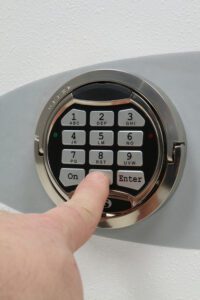Key Locks:
Pros:
- Reliability: Key locks are known for their simplicity and reliability. They do not rely on electronics or power sources to operate, reducing the risk of technical malfunctions.
- No Risk of Hacking: Key locks are not susceptible to hacking or electronic manipulation, providing a straightforward and secure means of access.
- Low Maintenance: Key locks require minimal maintenance compared to digital locks, as there are no electronic components to monitor or replace.
Cons:
- Risk of Key Loss: Keys can be lost, stolen, or duplicated, posing a security risk if they fall into the wrong hands. Rekeying or replacing locks may be necessary in such cases.
- Limited Access Control: With key locks, it can be challenging to control access or track usage, as physical keys can be easily shared or copied without detection.
- Inconvenience of Key Management: Managing physical keys for multiple users or locations can be cumbersome and may lead to organizational challenges, especially in larger settings.
Ultimately, the choice between digital safe locks and key locks depends on factors such as security requirements, convenience preferences, and budget constraints. Evaluating the pros and cons of each option can help determine the best fit for your specific needs.
Digital Safe Locks:
Pros:
- Convenience: Digital safe locks offer convenient access using codes, PINs, or biometric features such as fingerprints. Users don’t need to worry about carrying or losing keys.
- Enhanced Security Features: Many digital locks come with advanced security features like multiple access codes, time-delayed entry, and audit trails, providing added protection against unauthorized access.
- Ease of Management: Digital locks allow for easy management of access codes or PINs, enabling users to change them as needed without replacing physical keys. This flexibility is beneficial in shared environments or businesses with high employee turnover.
- Tamper Resistance: Digital locks are designed to be tamper-resistant, with features such as anti-tamper mechanisms and automatic lockout after multiple failed attempts, making them more secure against manipulation.
- Integration with Security Systems: Some digital locks can be integrated with security systems or smart home devices, allowing for remote monitoring and control, enhancing convenience and peace of mind.
Cons:
- Dependency on Power: Digital locks require power sources such as batteries or electricity to operate. In the event of a power outage or dead batteries, access to the safe may be temporarily restricted.
- Risk of Malfunction: Digital locks may be susceptible to technical malfunctions or electronic failures, potentially leading to lockouts or access issues.
Vulnerability to Hacking: While digital locks are designed to be secure, they may still be vulnerable to hacking or electronic manipulation, especially if not properly configured or maintained

